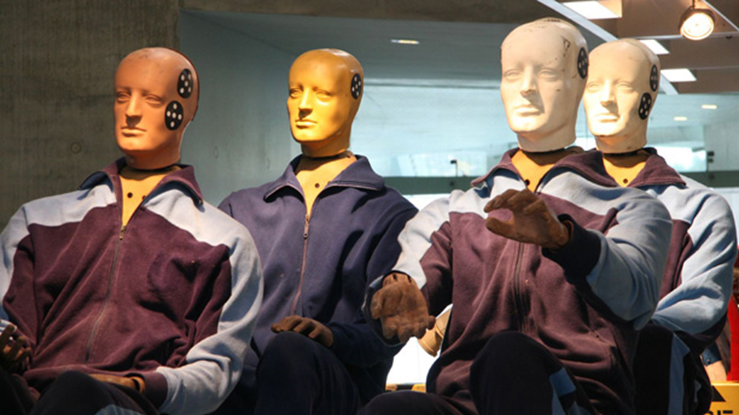For financial and research purposes, dummies are replaces by humans because they are cheaper and they give more reliable results. Facing budgetary pressures, researchers in Spain said they’re going to stop using crash test dummies and start using human cadavers.
According to an online report on Spain’s ABC channel, researchers at the Laboratory of Technology and Systems for Safety In Automobiles (TESSA) in Alcaniz in northern Spain are one of six places in the world where human-body crash tests were conducted. The Daily Mail said the bodies were cheaper than traditional crash-test dummies.
But researchers said using cadavers (which come from medical labs that have already used the bodies for their tests) will give them more data on what happens to internal organs during a crash.
While the practice of smashing dead bodies in cars may seem shocking, data from such experiments have saved thousands of lives. And it’s been going on for decades.
Newly developed crash test dummies owe their life-like technology to research done on cadavers of the past. When the field of biomechanics was still in its infancy, new and reliable data from real human bodies was needed before reasonable facsimiles for human bodies could be created.
Research began in the 1930’s when Lawrence Patrick first studied impacts on his own body. He quickly discovered those tests weren’t sufficient; he needed to test the limits of human endurance. First, he flung a cadaver down a Wayne State University elevator shaft to test the strength of a human skull. He found the skull can be subjected to a ton and a half of pressure for one second without damage. Since then, cadavers have been used to study multiple impact scenarios affects on different parts of the human body.
Using cadavers in crash testing isn’t as popular as it once was, but continues to this day in America and Europe. Auto manufacturers stick to crash dummies in their testing, since they don’t want to get involved in the messy job of handling human remains. Instead, universities around the world get money from the National Highway Traffic Safety Administration and the Insurance Institute for Highway Safety, and make the resulting data readily available to manufacturers. Because cadavers come so close to mimicking real people, the date gathered from such tests is invaluable. In a 1995 article in the Journal of Trauma, Wayne State researcher Albert King estimated that about 8,500 lives each year are saved as a result of crash research on cadavers.
Using cadavers has its drawbacks: Bodies yield imperfect data because no two cadavers are alike, and can only be used once in testing. Cadavers donated for scientific research also tend to be older and more fragile. OneNHTSA crash study noted the average age of cadavers used was 72. Younger cadavers are harder to come by, since car accidents are a leading cause of death for younger people. Once a body has been subjected to a crash it is useless for data gathering. Bodies must also have their lungs and veins re-pressurized before testing to better mimic living tissue. There are also very few studies done on pediatric cadavers, leading companies like Ford to develop their own pediatric crash test dummies.
For all their drawbacks, cadavers are still occasionally needed in safety testing, as imitations are not quite perfect. Today’s computer simulations and technologically advanced crash test dummies are used to gather more reliable data for comparison studies.



